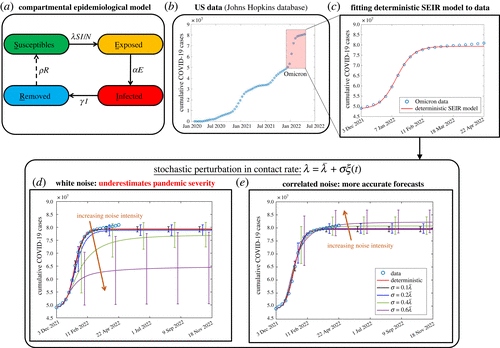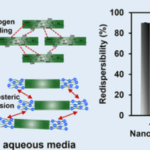2023-01-11 ノースカロライナ州立大学(NCState)
公衆衛生の専門家がCOVID-19のような感染症の広がりを予測する場合、コンパートメントモデルとして知られる数学的モデルを用いる。これらのモデルは、病気の状態に基づいて、集団を感受性、曝露、感染、除去といった異なるグループ、すなわち区画に区分する。各グループには方程式が関連付けられており、各方式には特定のパラメータが含まれています。方程式内の各パラメータの値を埋めて区画モデルを解くことで、保健当局は病気の蔓延の予測を作成します。
確率的コンパートメントモデルで最も重要なパラメータの1つは接触率で、これは(大まかに言えば)ある個人が特定の時間にどれだけの人と接触したかという平均値を定量化するものです。このパラメータは,その不確実性から,測定が最も困難なパラメータの1つでもある:モデル内の各人が,ある1日にどれだけの接触を行うかを,誰も実際に知らないのである.さらに、この1日の接触回数は一定ではなく、時間とともに変動します。
「モデル化における最大の課題の1つは、不確実なパラメータを扱うことです」と、NC Stateの数学助教授でこの研究の筆頭著者であるMohammad Farazmand氏は述べています。
「このような不確実性に対処する一つの方法は、モデルにランダムな揺らぎ、つまりノイズを加えて、現実世界と同じようにパラメータ値を変動させることです。しかし、そうすると思ったほど現実を再現できないことがわかりました。”
簡単に言えば、旧モデルでは、時間的に相関のない『ホワイトノイズ』、つまり変動が完全にランダムなものを使っているのです」とFarazmandは言う。「現実の世界では、今日の接触が明日の接触に影響します。例えば、今日10人の親しい友人とディナーパーティーに参加したとしても、明日同じことをすることはないでしょう。つまり、昨日の行動によって、接触率が変わってくるのです。
「その代わりに、個人の接触について合理的な仮定を立て、それに基づいて不確実性をモデル化すれば、モデルに加えるノイズは時間的に相関し、結果は現実にうまく対応するようになる」。幸運なことに、まさにそれを実現する相関プロセスがすでに存在しています – Ornstein-Uhlenbeckプロセスです。Farazmand氏がOrnstein-Uhlenbeck過程をモデルに適用したところ,Omicron変種の拡散に関する実際のデータと,モデルの予測がより近く対応するようになった.
この研究は、Proceedings of the Royal Society Aに掲載されています。 NC Stateの元ポスドク研究員で、現在ワシントン大学にいるMamisが筆頭著者です。
<関連情報>
- https://news.ncsu.edu/2023/01/researchers-improve-pandemic-prediction-model/
- https://royalsocietypublishing.org/doi/10.1098/rspa.2022.0568
COVID-19パンデミックの確率的コンパートメントモデルには、時間的に相関のある不確実性が必要である Stochastic compartmental models of the COVID-19 pandemic must have temporally correlated uncertainties
Konstantinos Mamis and Mohammad Farazmand
Proceedings of the Royal Society A Published:11 January 2023
DOI:https://doi.org/10.1098/rspa.2022.0568

Abstract
Compartmental models are an important quantitative tool in epidemiology, enabling us to forecast the course of a communicable disease. However, the model parameters, such as the infectivity rate of the disease, are riddled with uncertainties, which has motivated the development and use of stochastic compartmental models. Here, we first show that a common stochastic model, which treats the uncertainties as white noise, is fundamentally flawed since it erroneously implies that greater parameter uncertainties will lead to the eradication of the disease. Then, we present a principled modelling of the uncertainties based on reasonable assumptions on the contacts of each individual. Using the central limit theorem and Doob’s theorem on Gaussian Markov processes, we prove that the correlated Ornstein–Uhlenbeck (OU) process is the appropriate tool for modelling uncertainties in the infectivity rate. We demonstrate our results using a compartmental model of the COVID-19 pandemic and the available US data from the Johns Hopkins University COVID-19 database. In particular, we show that the white noise stochastic model systematically underestimates the severity of the Omicron variant of COVID-19, whereas the OU model correctly forecasts the course of this variant. Moreover, using an SIS model of sexually transmitted disease, we derive an exact closed-form solution for the final distribution of infected individuals. This analytical result shows that the white noise model underestimates the severity of the pandemic because of unrealistic noise-induced transitions. Our results strongly support the need for temporal correlations in modelling of uncertainties in compartmental models of infectious disease.


